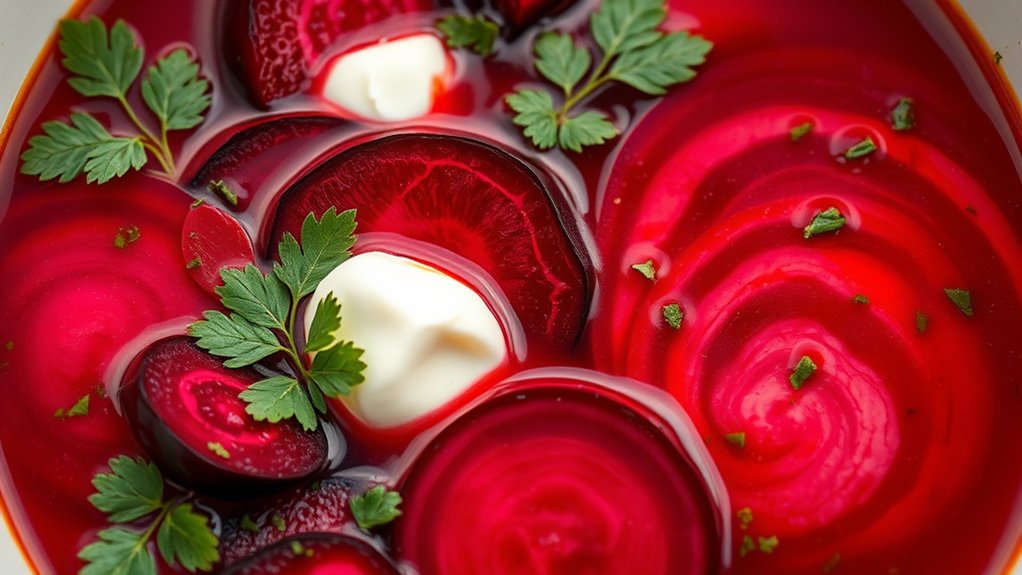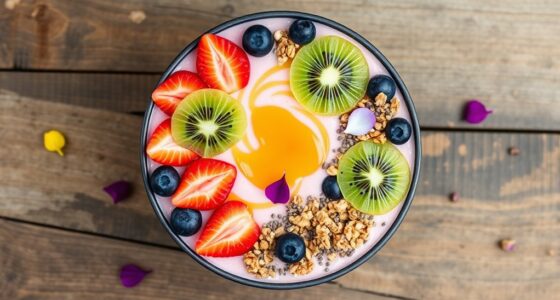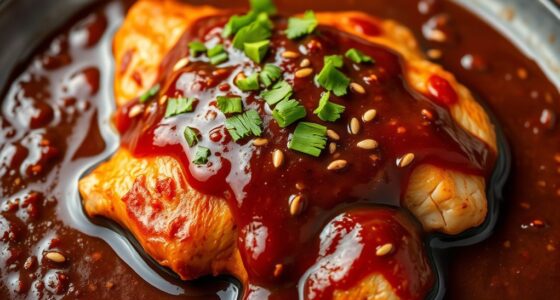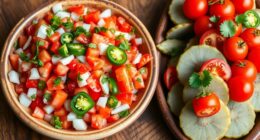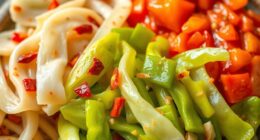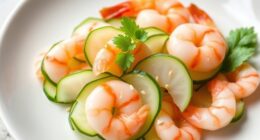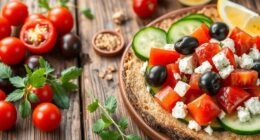In traditional Russian borscht, the beet variety you choose greatly impacts both flavor and appearance. Classic red beets give the dish a rich, earthy taste and vibrant crimson color. Golden beets add a brighter, milder sweetness, while deep purple or black beets offer a more intense, dramatic look and flavor. White beets produce a subtler, milder hue and taste. Explore different beet options further, and you’ll uncover how each influences your borscht’s unique charm.
Key Takeaways
- Classic red beets are used for traditional borscht, providing vibrant color and a sweet, earthy flavor.
- Deep purple and black beets add intensity, rich flavor, and dramatic dark hues to the dish.
- Golden beets introduce a bright, sunny color with a milder, subtly sweet taste.
- White beets offer a gentle flavor and neutral appearance, creating a subtle, refined look.
- Beet color choices influence both the flavor profile and visual appeal of Russian borscht.
The Classic Beets: Red Varieties and Their Characteristics
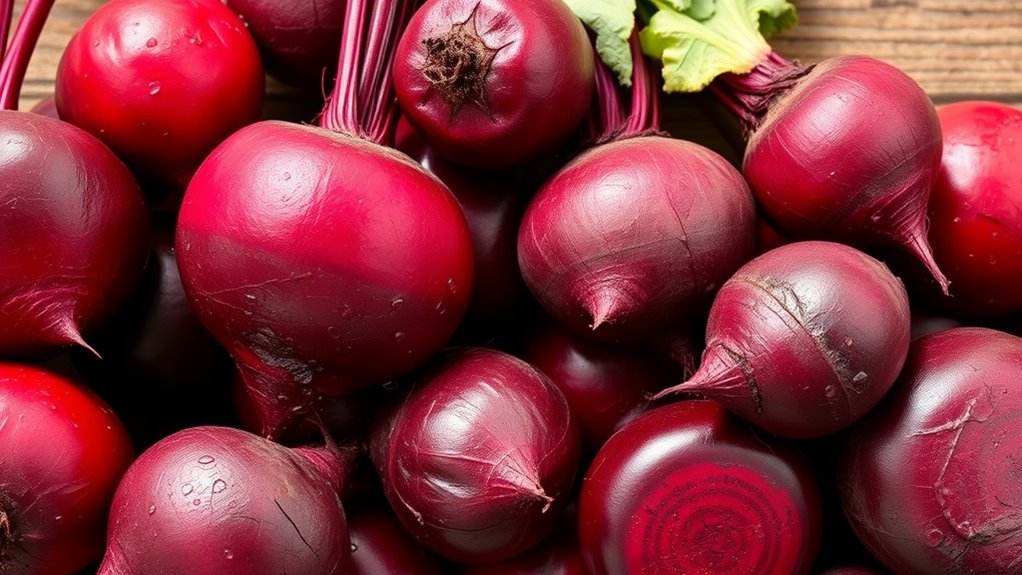
Red beets are the most well-known and widely used varieties for making traditional borscht. They offer a vibrant, deep crimson color that gives the soup its signature look. These beets have a sweet, earthy flavor with a mild bitterness, which balances well with the tanginess of vinegar and the richness of other ingredients. They tend to be round or oblong, with smooth skins and firm flesh. When selecting red beets, look for those that are medium-sized, heavy for their size, and free of blemishes. Their versatility makes them ideal for roasting, boiling, or steaming. Red beets also retain their color well during cooking, ensuring your borscht remains visually appealing and flavorful. Their consistent quality makes them a staple in traditional recipes.
Deep Purple and Black Beets: Adding Intensity and Richness
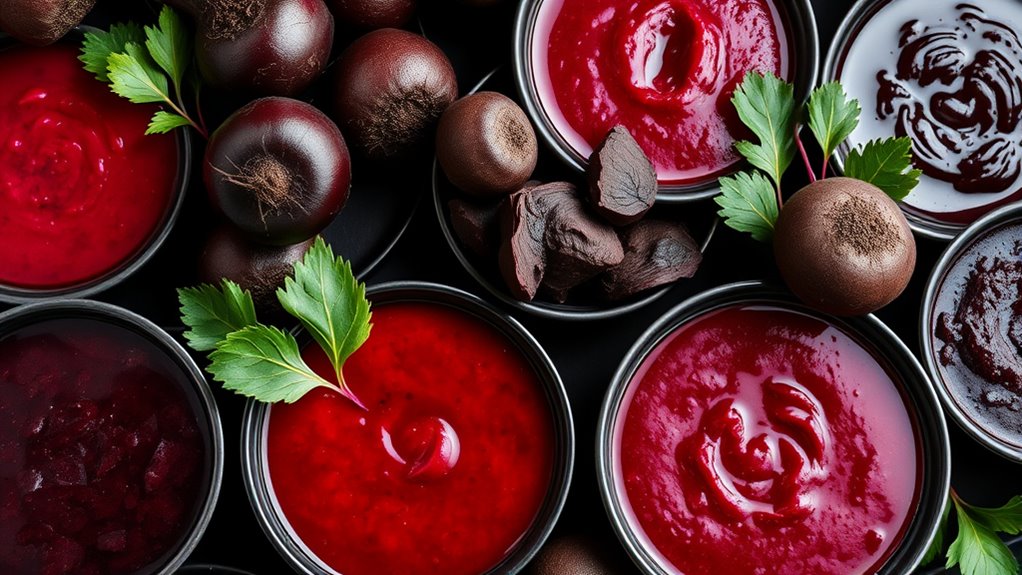
Deep purple and black beets bring a bold, intense flavor and a strikingly dark hue to your borscht, elevating its visual appeal and depth of taste. These varieties have a richer, earthier profile that adds complexity to the soup, making each spoonful more robust. Their deep coloration creates a dramatic contrast with other ingredients, giving your borscht an alluring, almost mysterious look. When cooked, they release a concentrated flavor that enhances the overall richness, making the broth more velvety and satisfying. You’ll notice that these beets also maintain their dark color even after simmering, lending a deep, vibrant tone to your dish. Using deep purple or black beets is a simple way to add intensity and a touch of sophistication to your traditional borscht. Additionally, these beets can contribute to the visual contrast that makes the dish visually stunning and appetizing. Incorporating these beets can also enhance the color and make the presentation more striking. Furthermore, their nutrient profile adds health benefits that complement the rich flavors of the soup. The natural pigments in these beets are known for their antioxidant properties, which can boost your health while enriching your meal. Including these beets can also support nutritional value, making your borscht not only more attractive but also more nourishing.
Golden Beets: A Bright Alternative for Borscht
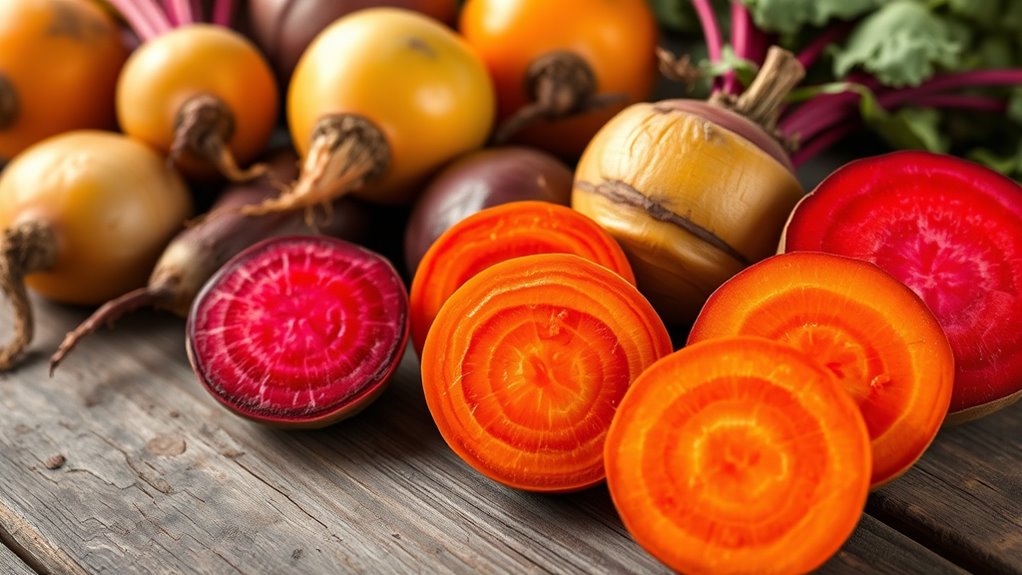
While deep purple and black beets add intensity and darkness to your borscht, golden beets offer a vibrant, sunny alternative that brightens up the dish. Their cheerful hue brings a fresh, inviting look to your bowl, making your soup visually appealing. Golden beets have a milder, slightly sweeter flavor compared to traditional red varieties, adding a subtle sweetness without overpowering the other ingredients. When cooked, they soften beautifully and blend well into the broth, creating a lighter, more delicate taste. Their bright color also helps highlight the vegetables and herbs, giving your borscht a lively appearance. If you’re aiming for a cheerful, less intense version of the classic, golden beets are an excellent choice that adds both visual appeal and a gentle flavor.
White Beets: A Mild and Subtle Option
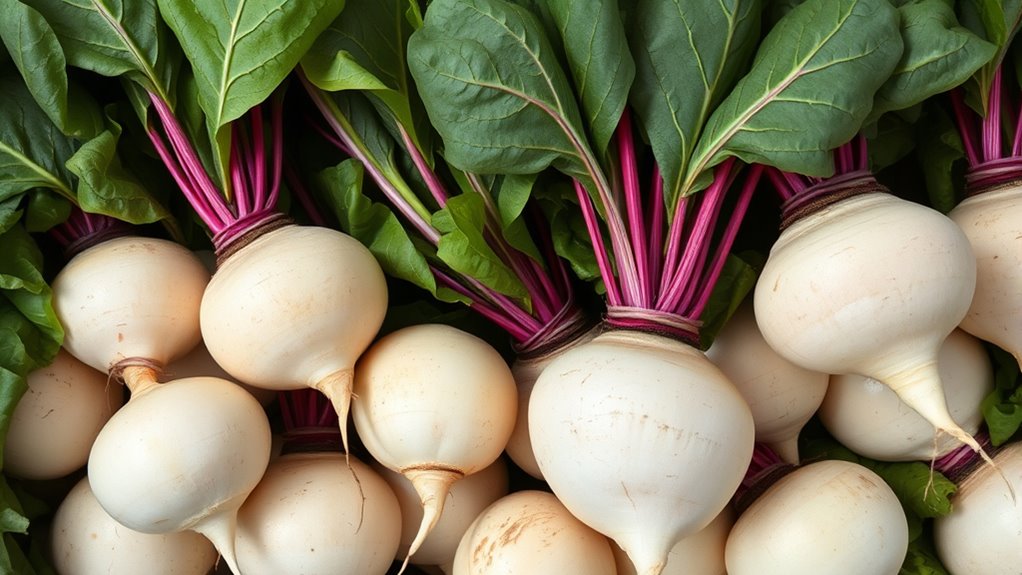
If you’re looking for a subtle alternative to more vibrant beets, white beets offer a gentle, understated flavor that complements your borscht without overpowering other ingredients. Their mild taste allows the natural sweetness of vegetables like carrots and onions to shine through. White beets have a delicate texture that blends smoothly into the soup, adding body without changing the color dramatically. Because they lack the intense pigment of red or golden beets, they create a more neutral base, ideal if you prefer a less bold appearance. These beets are versatile and absorb flavors well, making them suitable for a variety of seasonings and broths. Their subtle hue makes them an excellent choice for those seeking a more authentic rustic aesthetic, and overall, white beets provide a refined, subtle option for those seeking a milder, more nuanced borscht. Incorporating white beets can also be beneficial for color moderation, especially in dishes where visual appeal is as important as flavor. Additionally, white beets are known for their nutritional benefits, making them a healthy addition to your culinary repertoire.
How Beet Colors Influence Flavor and Visual Appeal
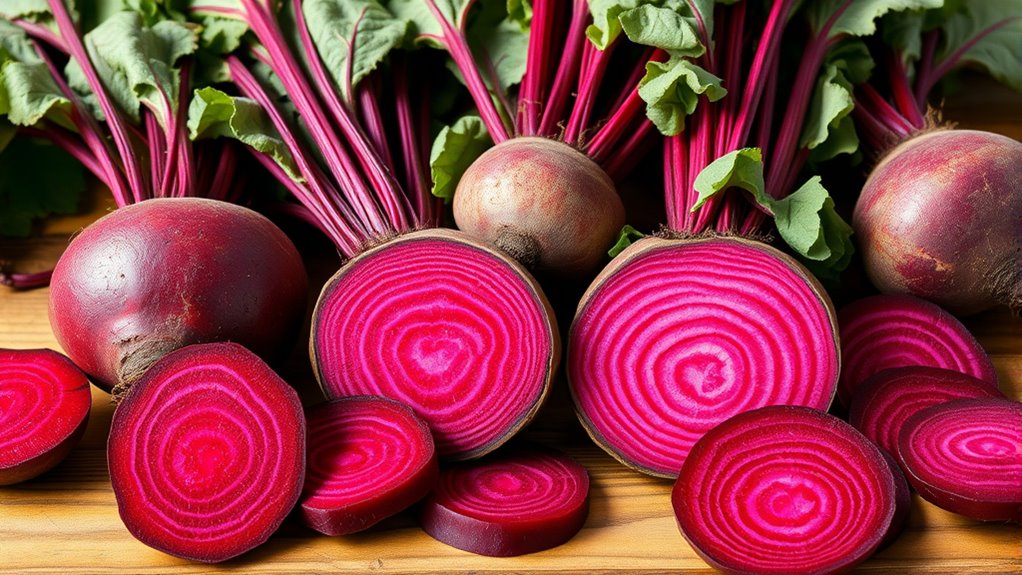
Beet colors markedly influence both the flavor profile and visual appeal of your borscht. Deep red beets create a rich, earthy taste that adds depth to the soup, while lighter varieties like golden beets offer a milder, slightly sweet flavor. The vibrant crimson hue makes your borscht visually striking, enticing diners with its bold color. Conversely, yellow or white beets produce a subtler appearance, giving the soup a softer look, but they still contribute a gentle sweetness. The color you choose can set the tone for the entire dish, making it more appetizing and memorable. By selecting different beet varieties, you control both how your borscht looks and how it tastes, ensuring a dish that’s as appealing visually as it is flavorful. Kia Tuning can serve as a reminder that just as different vehicle modifications alter performance and appearance, selecting beet varieties can customize the flavor and look of your borscht to suit your preferences. Additionally, understanding beet varieties can help you better appreciate the unique qualities each type brings to your cooking.
Frequently Asked Questions
Which Beet Variety Is Most Traditional for Authentic Russian Borscht?
You’re wondering which beet variety is most traditional for authentic Russian borscht. To make a classic borscht, you should choose the Dark Red or Crimson Globe beet, known for its deep color and rich flavor. These beets have the traditional crimson hue that gives borscht its vibrant appearance. Using these beets guarantees you stay true to the authentic taste and visual appeal of Russian borscht, making your dish truly traditional.
How Do Beet Varieties Affect the Nutritional Content of Borscht?
Beet varieties influence borscht’s nutritional content by varying their vitamin, mineral, and antioxidant levels. When you choose darker, more vibrant beets, you get higher amounts of nutrients like folate, manganese, and betalains, which boost your immune system and reduce inflammation. Different types may also have slightly different fiber contents and sugar levels. By selecting fresh, high-quality beets, you maximize the health benefits in your borscht.
Can Beet Color Influence the Shelf Life of Prepared Borscht?
You might wonder if beet color affects borscht’s shelf life. Generally, the pigment anthocyanins in beets can degrade over time, especially with heat and light exposure, leading to color fading. While vibrant color might suggest freshness, it doesn’t directly extend shelf life. Proper storage—cool, airtight conditions—matters most. So, the beet’s color can give clues about freshness, but it’s not a definitive factor for how long your borscht lasts.
Are There Specific Beet Varieties Better Suited for Freezing or Long-Term Storage?
When considering which beet varieties are better for freezing or long-term storage, you should look for those with dense flesh and firm texture. These varieties resist freezer damage and maintain quality longer. Heirloom or traditional types like Chioggia or Detroit Dark Red are excellent choices because they hold their shape and flavor better over time. Properly processing and vacuum-sealing your beets also helps extend their shelf life.
How Do Climate and Soil Impact the Color and Flavor of Different Beet Varieties?
Imagine climate and soil are the secret artists behind your beets’ stunning hues and bold flavors. You’ll notice that warm, sunny days and rich, well-drained soil turn your beets into vibrant reds or deep purples, bursting with flavor. Conversely, cooler temperatures and nutrient-poor soil can dull their color and mellow their taste. So, your environment crafts the perfect backdrop for your beets’ dramatic color and unforgettable flavor.
Conclusion
Choosing different beet varieties for your borscht is like selecting colors for a painting—each hue brings its own mood and flavor to the canvas. Whether you opt for the classic red, the deep purple, the sunny golden, or the subtle white, you’re adding your own unique touch to this timeless dish. Embrace the spectrum, and let your borscht become a vibrant tapestry of color and taste that delights both the eyes and the palate.
